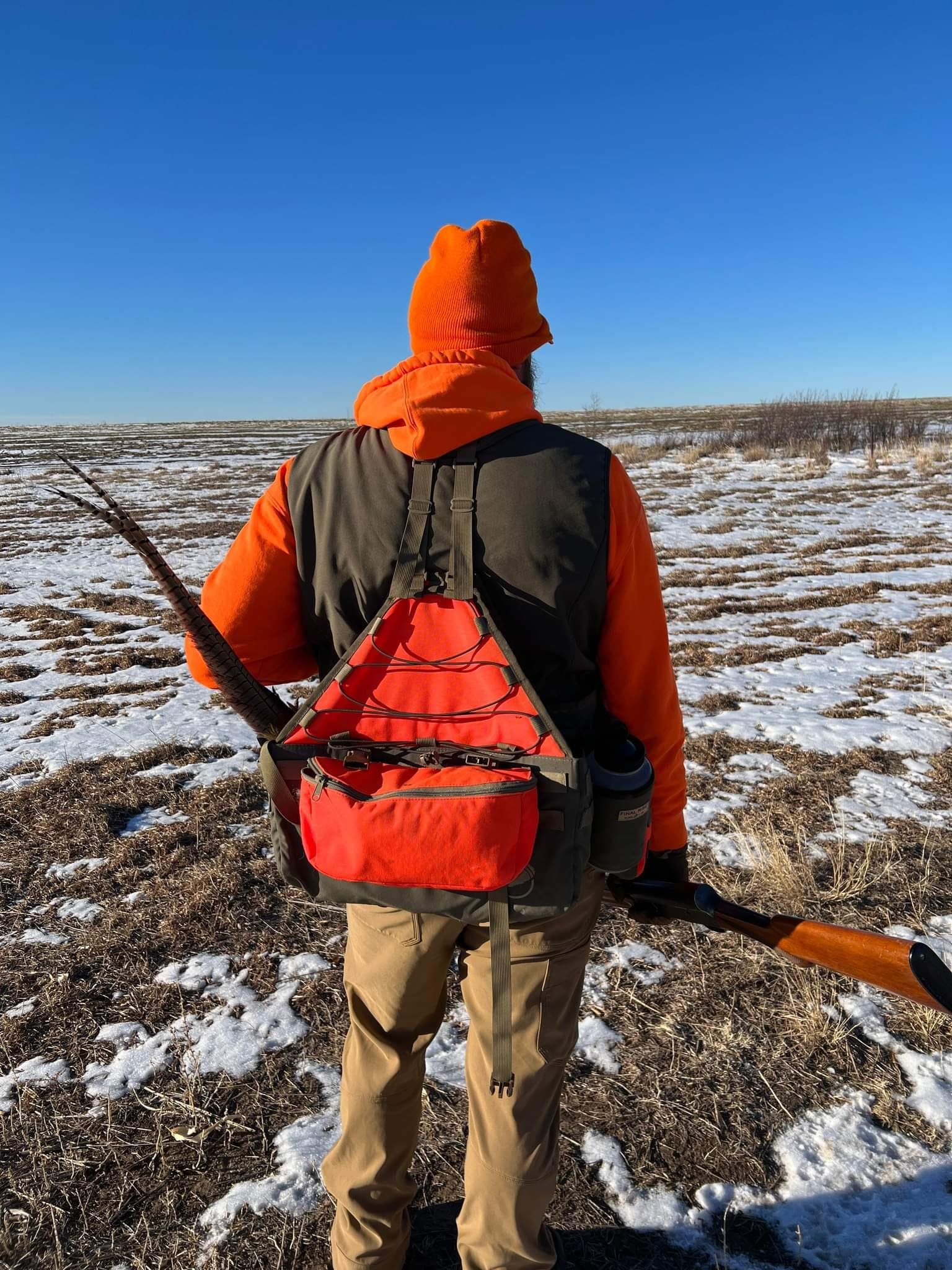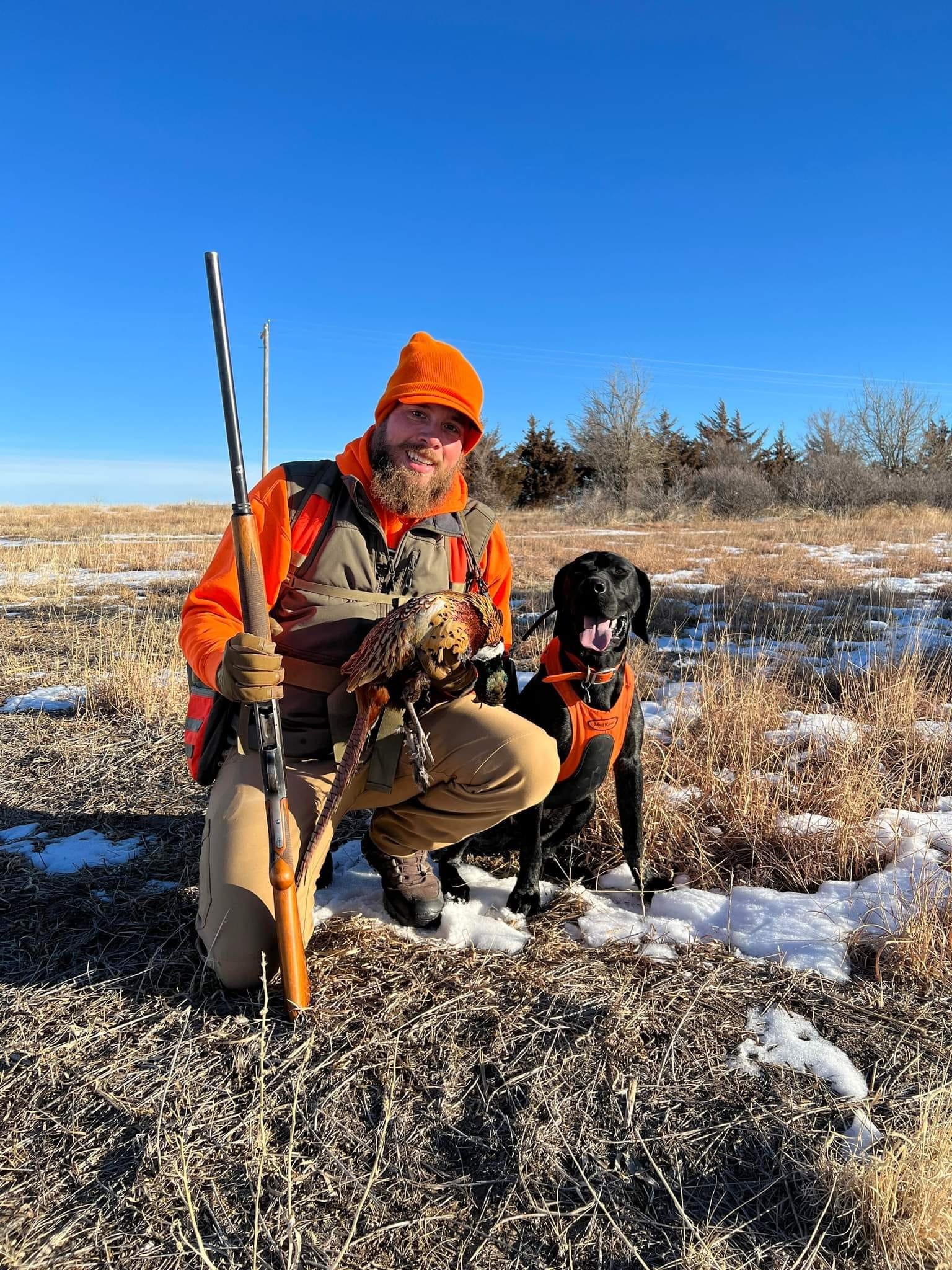Upland Hunting for Beginners
By Bobby Cole - Kansas Program Coordinator
As I write this, it’s a cool 60 degrees and raining. That’s a stark contrast to the last three weeks of 100+ degree temps! This cooler weather has me daydreaming about my favorite time of year! What’s that you ask? Upland bird season is the answer! It’s hard to beat walking the uplands with a few good buddies and even better dogs. If the flush of a bird, the squeeze of the trigger, and a retrieve to hand don’t get your heart beating, I honestly don’t know what will!
I have been lucky enough to be chasing upland birds for most of my life. I remember trudging along in my father and grandfather’s tracks through knee-high snow, watching in awe as they would flush a pheasant or quail and knock those impossibly fast birds out of the sky with a single shot from an old A5! As soon as that bird hit the ground, I would do my best to get to the bird before the dogs did. I remember turning a rooster over in my hand and being amazed at all the colors in their feathers. I was lucky to be raised by such men. Men who passed their passion for the outdoors on to me.
Looking back at how I got started makes me want to share my experiences with others so they can make their own memories. Participation in upland hunting has seen a considerable decline in the last 20 or 30 years. Several factors cause this, but a big part is people don’t know where to go and/or what is needed to get started. Well, my friends, I’m here to help you with that!
Where To Hunt:
Let’s talk about habitat. Upland birds require large open spaces. Look for places with native grasses and forbs. Like all animals, Upland birds need three things to survive—food, water, and shelter(cover). Food: look for grasses and weeds that produce a bunch of seeds. Good examples are ragweed, smartweed, blue stem, switchgrass, and, of course, ag fields. Water: find places that offer a water source. Farms ponds, creeks, and windmills are great water sources. Cover: Quail prefer edge habitats where different plant communities meet, like native grass near a food source, where grass meets shrubs such as plum thickets and sumacs. Often, I’ll find quail in shorter grass that borders taller grasses. Pheasants, in my experience, like thicker cover. Draws full of tall grass, ragweed, and cattails that border ag fields are great places to find pheasant. Later in the season, when snow is on the ground, tree rows can hold high numbers of pheasants.
Scouting is the most important thing you can do when hunting anything. When scouting for upland birds, focus on areas offering food, water, and cover within a few miles. Can you find upland birds outside of those areas? Of course, you can, especially later in the season, but if you focus on those areas, you will tend to have more luck. My last piece of advice on where to hunt is to walk the extra mile. Go off the beaten path, and you will be surprised at what you find.
When to Hunt:
Most other forms of hunting require that you be in the field long before the sun comes up. But not upland hunting! The great thing about upland birds is they will be in the field all day long; however, the time of the day does dictate where I will target the birds. Early in the morning, I will target birds close to their roost sight, usually a place with thick cover. Mid to late morning, you will find them in or very close to a food source. From early afternoon to midafternoon, they will usually be somewhere in between the roast or food source; often, they will be hanging out on a south-facing slope where they can get plenty of sunshine. Late afternoon, or as many hunters call it, the “gold hour,” is your last opportunity. You will find the birds leaving the food source heading for a roost. This is the time that many upland hunters believe is the best time to hunt. Upland birds will act differently in different areas, so it is very possible that you could run into a situation opposite of what you just read. The key takeaway is that you can successfully hunt upland birds all day long. Just get out and do it!
How to hunt:
Upland hunting, at its core, is simple. You find the right cover, start walking, and eventually flush a bird. Once you flush a bird, you shoulder your firearm, point it at the bird, fire, and then recover the bird. Rinse and repeat. There are a few tips to help you be a better upland hunter. First, when walking a field walk with the wind blowing into your face, this will do several things. If you are using a dog, it will make it easier for the dog to catch a bird’s scent. It will make it harder for the birds to hear you, making for closer shots. When a bird flushes, it will usually flush away from you. When the wind is in your face, the bird should fly into the wind, temporarily slowing them down, but be prepared; once the bird catches the wind, you will lose your chance. Use the landscape to your advantage; if you know there is a draw that holds birds or a plum thicket that usually holds a covey, approach it from a direction where the birds won’t be able to see or hear you until you are right on top of them. Move slowly with a purpose and have a plan for what you will do next. A lot of the time when hunting, I’ll find that we are walking way too fast. When that happens, you will walk over a bunch of birds, take your time, and it will make for a better hunt. Sometimes, you just need to stop in a field and stand still; it is surprising how often this will make a bird flush.
What You Need:
In all reality, you only need a few things to upland hunt. A trusty shotgun, ammo (recommended 2¾” #5 or #6), orang vest and hat, and a good pair of boots! Don’t fall into all the theatrics; you don’t need the best vest, brush pants, and a $3,000 shotgun! Trust me, I have killed more birds with a hand-me-down 870 in a pair of blue jeans than most people will kill in their lifetime. Don’t get me wrong, all the fancy gear makes for a more comfortable hunt, but it’s unnecessary. Some people will say, “You can’t upland hunt without a dog.” That is simply not true. I know several people who are very proficient upland hunters who don’t have a dog. Heck, I didn’t start using a dog until about three years ago. However, it is 100% true that you will have more opportunities if you hunt with a well-trained dog.
Final Thoughts
My best advice for someone who wants to get into upland hunting is to find yourself a mentor. Join a local Pheasant or Quail Forever chapter, or get on Facebook and find an upland hunting page for your state. Let them know that you’re new to it and ask for advice, ask, and see if anyone would be willing to mentor you. Having a Mentor outdoors is the best way to learn. They will help you avoid some of the mistakes a novice would make and point you in the right direction for needed gear. Show them that you are eager to learn and listen, and it shouldn’t be hard to find a mentor. If you can’t find a mentor, get out and do it. Please go out and walk, make mistakes, and learn from them.
Good luck, and happy hunting!




